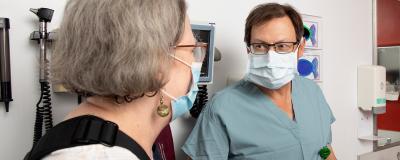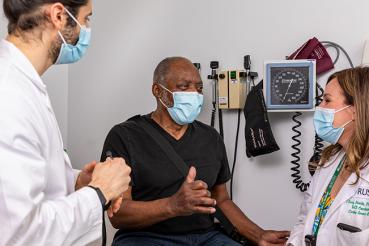A ventricular assist device, or VAD, is a mechanical pump that supports your heart's pumping action and circulates blood through the body.
The overall goal of VAD is to improve your health and quality of life. Since the pump helps circulate more oxygen-rich blood, most people report feeling better and having more energy to carry out daily activities. In many cases, the improved circulation may prolong your life, improve some organ damage caused by heart failure and reduce your heart failure symptoms.
Cardiologists and cardiac surgeons who specialize in heart failure and mechanical circulatory support offer VAD for either temporary support or as destination (long-term) therapy. These experts — who have decades of experience treating heart disease and providing VAD therapy — will work with you to develop a treatment plan that fits your health needs and offers you the best possible quality of life.
What is a Ventricular Assist Device?
A ventricular assist device, or VAD, is a mechanical pump that supports the heart's pumping action and circulates blood through the body for patients with weak hearts or heart failure. The VAD does not replace your heart; it works with your heart to help it pump more blood with less work. It does this by taking blood from the ventricle and, depending on the type of device, moving it to either the lungs or the aorta and out into the body.
The VAD has both internal parts that stay in the body and external parts outside of the body. The actual pump sits below your heart’s ventricle with a tube attached that directs the blood. A cable, called a driveline, extends from the pump out through the skin and connects the pump to a controller and power sources worn outside the body.
The driveline must be connected to the controller, and the controller must stay connected to power at all times to keep the pump working properly. The pump is powered by batteries or electricity.
The RUSH Approach to Ventricular Assist Device Surgery
In advanced stages of heart disease or heart failure, when medical management isn't enough for treatment, a ventricular assist device may be an option for you.
RUSH cardiologists and cardiac surgeons who specialize in heart failure and vascular care offer ventricular assist device surgery for either temporary support or long-term (destination) therapy. These experts — who have decades of experience treating heart disease and providing VAD therapy — will work with you to develop a treatment plan that fits your health needs.
The overall goal of VAD is to improve your health and quality of life. Since the pump helps circulate more oxygen-rich blood, most people report feeling better and having more energy to carry out daily activities. In many cases, the improved circulation may prolong your life, improve some organ damage caused by heart failure and reduce your heart failure symptoms.
When used for temporary support, a VAD acts as a bridge to transplant for advanced heart failure patients waiting for a donor heart to become available. Finding a donor heart may require anywhere from days to a few months or years. The VAD is removed when a patient gets a heart transplant.
For long-term therapy, a ventricular assist device is a treatment for patients in advanced stages of heart failure who are not eligible for heart transplantation. The VAD is in place permanently in these cases.
Who Is a Good Candidate for Ventricular Assist Device Surgery at RUSH?
The Centers for Medicare & Medicaid Services set criteria and regulations about who can be eligible for VAD surgery. These include factors like a patient’s class of heart failure and the types of therapy they’ve already tried, among others. Your RUSH cardiologist can go over these criteria with you to see if you’re approved for a VAD.
Other factors are judged on a case-by-case basis, but there are a few things that make care more difficult.
Our physicians like to ensure that patients will have someone to assist with their ongoing care at home, whether that be a family member or another stable caregiver. Patients also should have access to electricity to power their VADs.
Heavy drug use may make a patient a poor candidate for surgery. Advanced kidney disease and other diseases can make the surgery riskier.
Meeting with a RUSH cardiologist is the best way to know for sure whether you qualify for VAD surgery and understand your individual risks and options.
What to Expect Before, During and After Ventricular Assist Device Surgery
When other methods of heart failure treatment aren’t working for you, our advanced heart failure care team will perform an evaluation to see if you should get VAD surgery.
Your cardiologist will begin educating you on the surgery and the VAD itself so you can be a part of all decision making. They’ll show you the equipment and even provide you with a wearable version of the device so you can know what it will look like.
They’ll also run tests and make sure you meet the criteria for VAD surgery. Based on the results of your labs and tests, they’ll introduce you to the specialists who may need to assist with your treatment.
Your care team will include patient navigators and coordinators who will help schedule your appointments. You may meet with psychologists who can provide you with coping skills and take care of your mental health. Social workers can help make sure you’re prepared for life after surgery. Palliative care specialists will be available to maintain your quality of life.
Once your surgery is scheduled, you may need to remain at the hospital for a few days before the surgery for monitoring if you are not hospitalized already.
The procedure takes about four to six hours with prep time, but the actual surgery takes about an hour. During that whole time, you’ll be intubated and completely under anesthesia, so you will not be awake for the surgery.
When you wake up, you will still have a breathing tube. You will also have tubes in your chest that will collect drainage and make sure there isn’t too much pressure on your heart or lungs. You’ll have some lines in your neck for monitoring and for giving you medication.
Your VAD will be working at that time, and it will be connected to a controller and power source. Within 24 hours, you will likely no longer need to be intubated.
You will spend some time in the intensive care unit until you are healthy enough to transfer. Patients spend an average of about 20 days in the hospital following the procedure. As you recover, your care team will educate you and your at-home caregiver on what to expect for lifestyle changes and using your device.
From there, depending on your needs, you’ll either go to a subacute nursing facility, acute inpatient rehab or home to continue physical therapy. If you go home, a home health team will follow up with you until you are well enough for cardiac rehab. You’ll have appointments at the RUSH VAD clinic to oversee your ongoing care.
Types of Ventricular Assist Devices
Each type of VAD is named for the chamber of the heart it supports.
- Left ventricular assist device (LVAD): The most commonly used VAD, by far, is a left ventricular device or LVAD. This is because the left side of the heart is typically the side that gets sick first in heart failure patients. The LVAD helps the left ventricle pump blood to the aorta, the artery that carries oxygen-rich blood from the heart to the body. LVADs can serve as a bridge to heart transplant while you wait for a donor heart. They are also often used to support the heart indefinitely, as an alternative to heart transplant surgery.
- Right ventricular assist device (RVAD): An RVAD helps the right ventricle pump blood to the pulmonary artery, which carries blood from the heart to the lungs. It is typically used only for temporary support — after LVAD implantation or other heart surgery — while your heart recovers. Once your heart regains its strength, the RVAD is removed.
- BIVAD: When an LVAD and an RVAD are used at the same time, they are called a BIVAD. This combined approach supports both of the heart's pumping chambers in cases where neither chamber works well enough to meet your body's needs.

RUSH Excellence in Ventricular Assist Device
- Among the best in the U.S.: U. S. News & World Report includes RUSH University Medical Center on their Best Hospitals Honor Roll and ranks it among the best hospitals in the nation for cardiology and heart and vascular surgery.
- Experienced care, excellent outcomes: Our surgeons implant the most LVADs in the Midwest, and RUSH has among the highest survival rates in the country for heart failure patients. We also have infection rates far lower than the national average, and over 90% of patients report an improvement in quality of life after VAD surgery.
- Holistic support every step of the way: Cardiac surgeons and cardiologists who specialize in heart failure and mechanical circulatory support provide expertise and guide you and your family every step of the way, whether your VAD is a bridge to transplant or long-term therapy.
- Convenience and collaboration: While you may have your ventricular assist device surgery performed at RUSH University Medical Center, you can benefit from convenient follow-up care at a number of convenient locations in Chicago, Aurora/Fox Valley and the suburbs.
FAQs About Ventricular Assist Device
No, a pacemaker is different from a ventricular assist device. If you have a pacemaker, you’ll likely still need it after VAD surgery.
If you think of your heart like a house, a pacemaker handles the electricity, while the VAD takes care of the plumbing. A pacemaker regulates the electrical signals within the heart, and a VAD keeps blood pumping through the heart. You need both for your heart to have healthy function, just as you need both electricity and plumbing in your house.
The most common ventricular assist device is the left ventricular assist device, or LVAD. This is because the left side of the heart is typically the first side to start functioning poorly and show symptoms of heart failure. It is also closer to the aorta that pumps oxygenated blood to the rest of the body.
The VAD works as a pump. It has an inflow cannula, an opening that connects to the left ventricle and pulls blood into the pump from the heart. A motor spins the blood and keeps it moving through the pump.
The blood then moves through an outflow cannula, an opening that is outside of the heart and connects to the aorta and pumps blood to the rest of the body.
Finally, there is the driveline. It’s a tube that connects to the VAD and extends outside of the body to connect to the controller. The controller shows how much blood is flowing through the pump. If the flow needs to increase or decrease, the controller can adjust the speed of the motor.
The controller has batteries that act as a power source to keep the motor running. The batteries usually give 10 to 14 hours of power. The controller can also connect to a wall outlet for continuous power.






